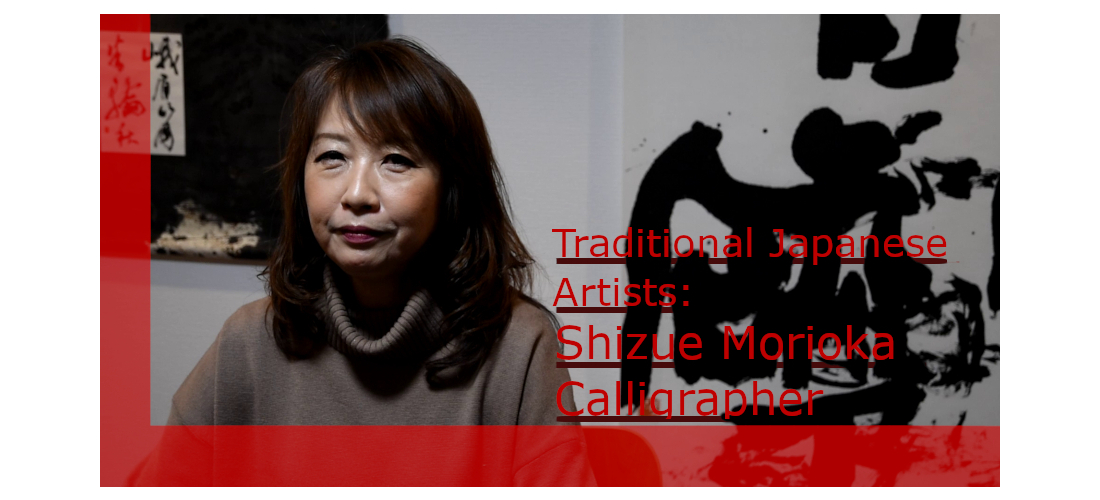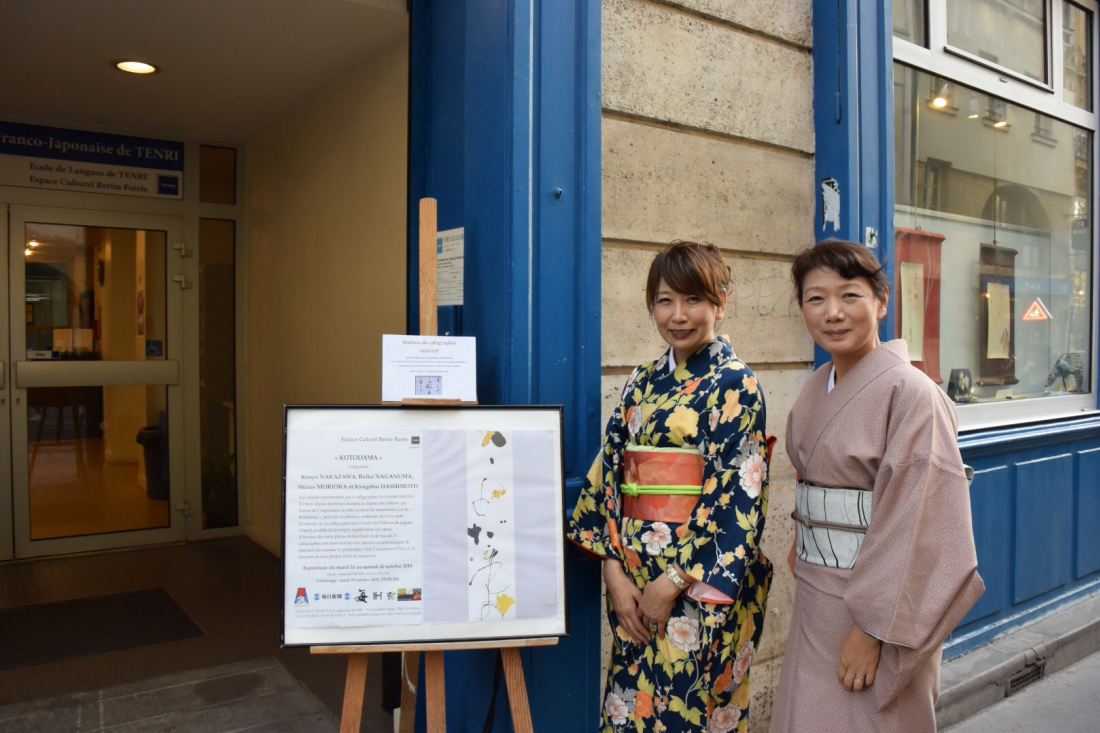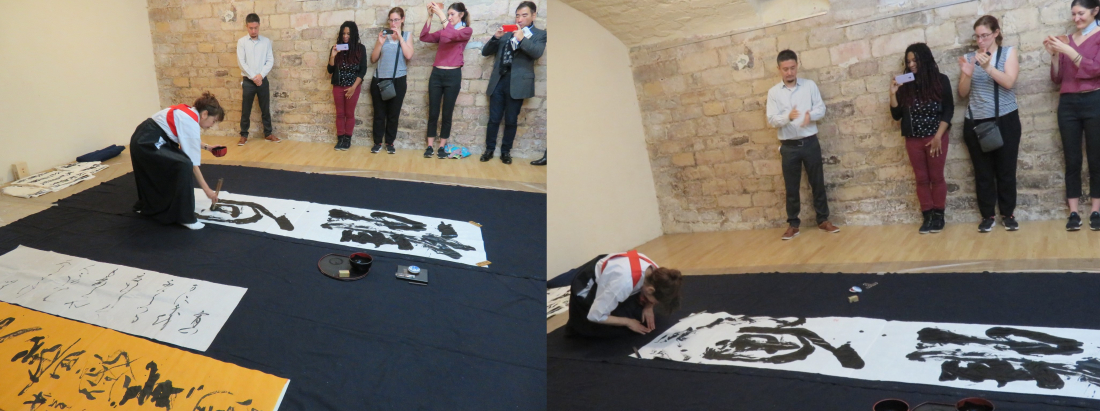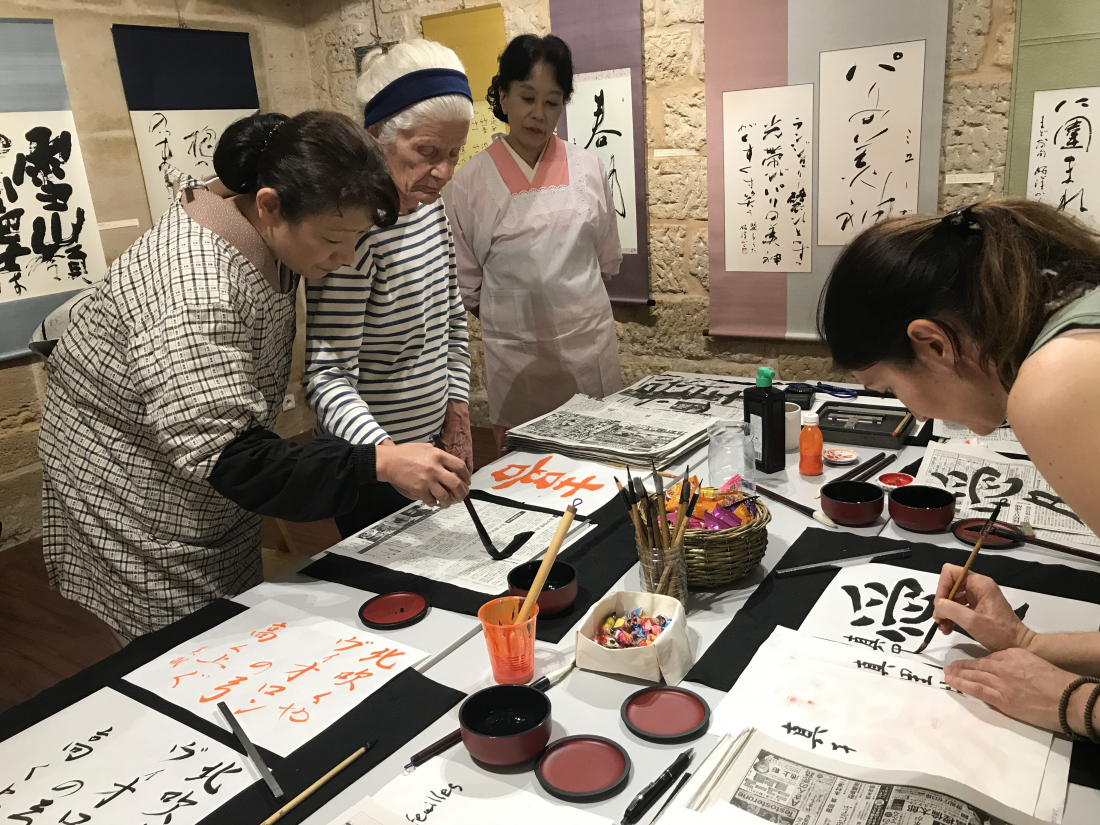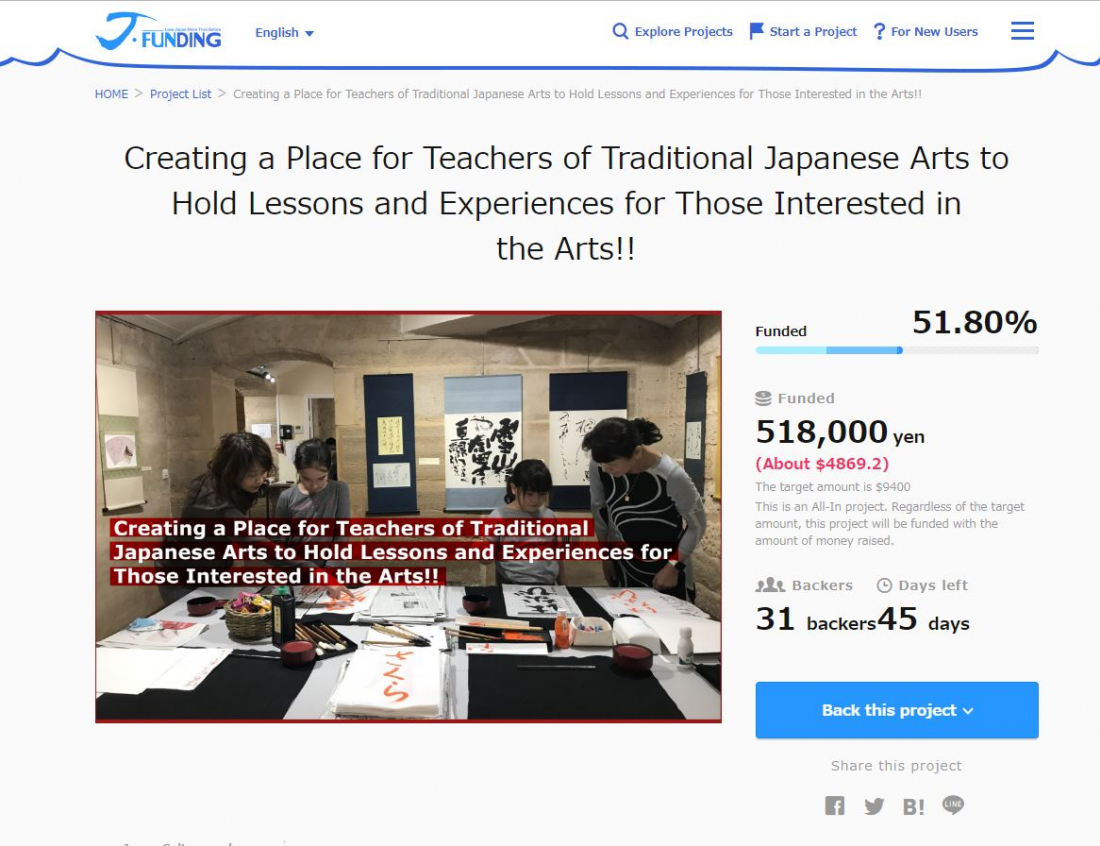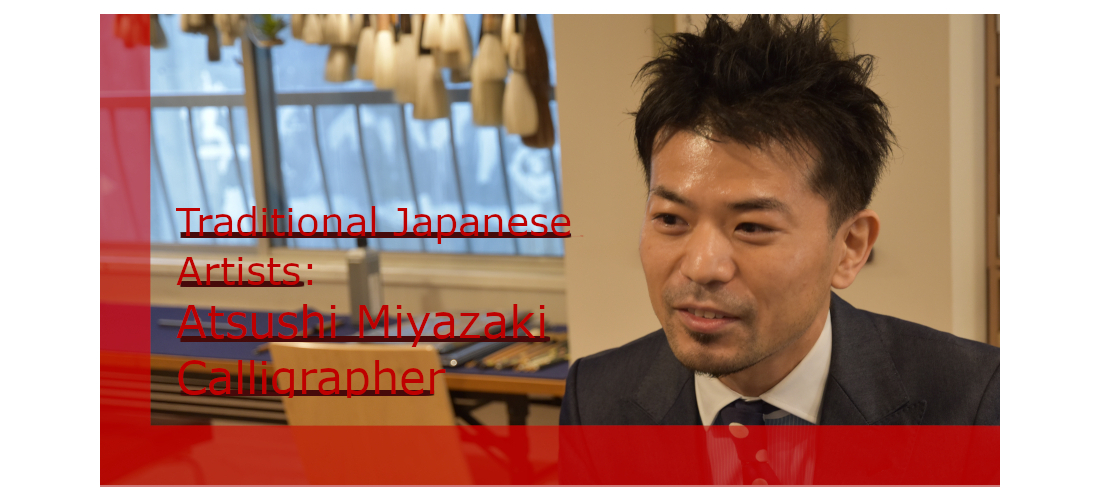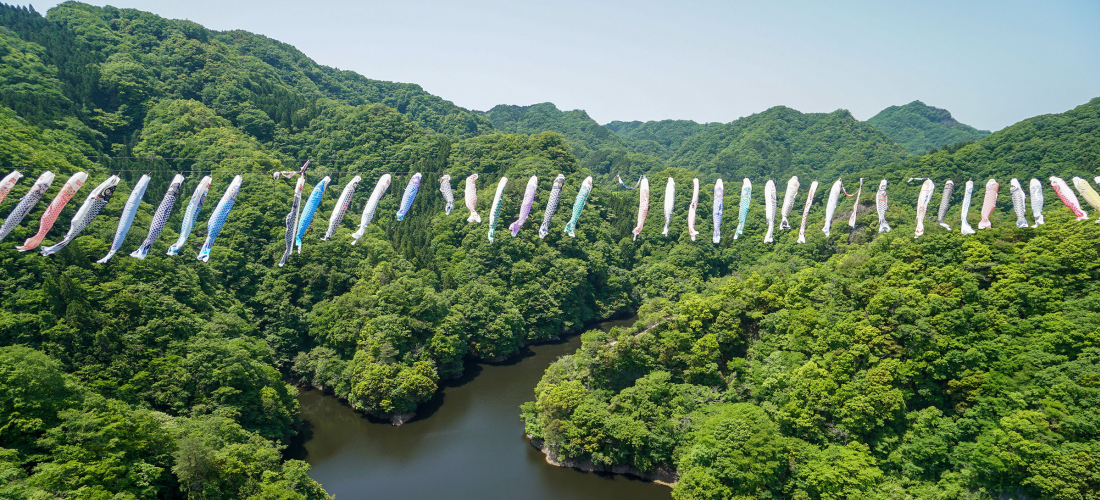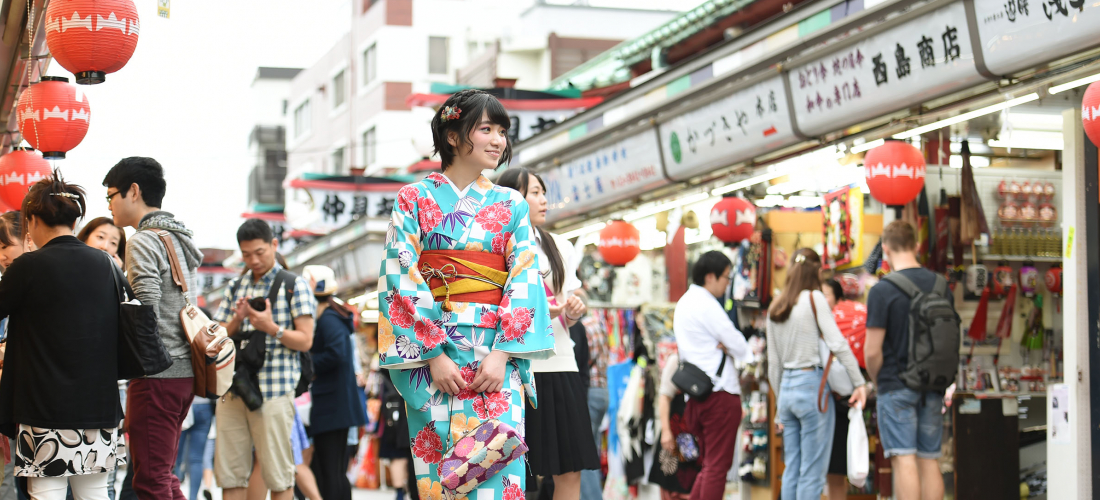CONTENTS
In this series we want to take a look at some amazing traditional Japanese artists, this time looking at Shodoka (書道家) or Japanese Calligrapher, Shizue Morikoa (森岡 静江). By doing so, we hope to interview some interesting and talented artists, so that you can find out more about wonderful traditional Japanese arts.
A quick background on Shodō
The practice of Japanese Calligraphy or Shodō (書道) has been around for over 1,500 years, dating back to when Chinese characters or Kanji was introduced to Japan. Examples can be found dating back to around 686 AD. Over the years the way of writing has changed, with a variety of styles occurring. There are three main styles that are in use today:
"Kaisho"楷書(かいしょ): A style where the artist deliberately makes each stroke recognisable, and is easiest to read. This would be seen as being closest to printed text.
"Gyosho"行書(ぎょうしょ): A style where strokes are less deliberately made. This is seen as being one of the most common forms of Shodō and the foundation for many schools of calligraphy in Japan.
"Sosho"草書(そうしょ): A style that is highly stylised and is made normally with the artist's brush rarely leaving the page. Due to being highly stylised, without mastering the art, it can be nigh impossible to read. This is seen as being the main style for artists to shine in.
Previous Interviews
Previously in this series we held an interview with Atsushi Miyazaki, who told us about his own experiences with the beautiful art that is Shodō! You can find his interview here!
A Look at Shizue Morioka
Q: How did you start learning Japanese Calligraphy?
A: I started shodo when I was young. Back then, everyone around me would go to learn shodo, this was around elementary school age. From then, we all went and enjoyed ourselves while learning shodo.
Q: Why did you carry on learning and then teaching?
A: When asked why I've carried on all these years, I don't have a real answer. It's more the fact that I just haven't stopped and it's become a part of me now. If I was to stop now, the person that is Shizue Morioka would cease to exist.
When it came to other people, they had their reasons to stop, but I didn't. I just liked to do it. Then when it came to thinking about my future, I felt that my only skill was in Shodo, so I wanted to be able to use that in the future.
Q: What does Shodo mean to you?
A: When it comes to what Shodo means to me, I think the most appropriate answer is Self Expression. For say muscians, music is their way to express themselves, for many people they have their own tools to express themselves, but for me, Shodo is the way I can full express myself.
A: I think when it comes to Shodo, it is a special type of art. It can be quite a spiritual process. Of course other arts have this as well, but when it comes to Shodo, no matter how many times you try, it is impossible to draw the same kanji exactly the same. I think that this is one of the most important parts of Shodo. With this, the parts of you that feels sad, or feels lonely, or feels happy are able to come out and it can be an amazing experience. It doesn't matter whether you are good at drawing or bad, its what happens in the moment that matters.
Q: Why do you want foreigners to learn about Shodo?
A: When it comes to having foreigners learning about Shodo, I've been lucky enough to have exhibitions overseas. One of the biggest take aways from this has been all those that have come into contact with it has been extremely respectful of it. As well as this, Japonism was seen quite a lot in the West in the past, and I would like to see another resurgence of this Japonism in the future!
Q: Why should foreigners learn about Shodo?
A: When it comes to Japanese Calligraphy, I think it is an art of the heart. What I mean by that is that more than other forms of art, you are able to pour your spirit and passion into this form of art more than other forms. It also has a complete sense of uniqueness, no matter how many people try to draw the same character, it's impossible to recreate the same character in the same way. This is not just because the way the brush falls on the paper, but how you put your feelings in to it as well, changing the character with each stroke. I think this is why foreigners could benefit a lot from experiencing or learning Japanese Calligraphy.
Q: What merits does this project have for foreigners?
A: I think until with this project and workshop, there hasn't been anything like it before, and you can enjoy a part of the art world like never before. I think this will be a great turning point to bring Japanese art to the rest of the world.
Q: What is the difference between teaching foreigners and Japanese people?
A: When it comes to Japanese people, they come to become better at making beautiful characters, but when it comes to foreigners, they wish to learn more about making art, as they don't normally have the language knowledge behind the characters.
Q: Why should foreigners learn about other traditional arts other than Shodo?
A: Japan has an amazing amount traditional types of art not just shodo, such as Sado( Tea Ceremony) or Kado (Flower Arranging). If foreigners are able to learn about these traditional arts, and us Japanese people are able to learn about their traditional culture, it will lead to a better understanding of each other and bring us closer.
Crowdfunding to raise money for a workshop for professionals to gather and teach foreigners
Currently Japan Culture and Technology, Inc (J-CAT) are raising money to create a workshop space for talented Shodō professionals to be able to teach foreigners that come in to Japan and wish to learn from a true professional!
You can find the project at the following link:
https://en.japankurufunding.com/projects/culture-workshop/
A variety of returns have been prepared for example workshop experiences as well as the chance to get your own custom piece of art from a professional Shoka!
We hope you can have a look at this project and support it!
PROFILE
Hey everyone! We hope that we can help you keep up to date with all the projects and things we have going on over at Japankuru Funding! We hope that you find the projects on the site as interesting as we do!
COMMENT
FEATURED MEDIA
VIEW MORE
Narita Airport Tax-Free Shopping List 나리타공항 면세점 쇼핑 리스트 #pr #calbee #jagapokkuru #japanesesnacks #japanesefood #japanesesouvenir #japantravel #japantrip #naritaairport #hokkaido #나리타국제공항 #나리타공항면세점 #나리타공항면세점과자 #일본공항면세점 #일본기념품쇼핑리스트추천 #공항면세점쇼핑리스트 #일본과자추천 #면세점일본과자 #일본기념품추천 #일본과자 #자가폿쿠루 #일본간식 #일본과자쇼핑 #일본면세점필수템 #일본기념품쇼핑

Asakusa's Sanja Matsuri, one of the biggest festivals in all of Tokyo, is almost here! Make sure you check out the festival route so you don't miss all the festivities this May. #asakusa #sanjafestival #sanjamatsuri #asakusashrine #sensoji #sensojitemple #japanesefestival #shintoshrine #japaneseculture #tokyo #tokyotrip #tokyotravel #asakusasightseeing #matsuri #japantrip #japantravel #springinjapan #tokyotravel #japankuru #산자마츠리 #아사쿠사 #일본마츠리 #일본여행 #일본5월

Odaiba's DiverCity Tokyo Plaza is home to the famous real-size 20m-tall Unicorn Gundam, and the popular shopping center has even more Gundam on the inside! Check out the Gundam Base Tokyo on the 7th floor for shelves upon shelves of Gunpla, and the Gundam Base Tokyo Annex on the 2nd floor for cool anime merchandise. Both shops have tons of limited-edition items! #pr #odaiba #tokyo #tokyotrip #japantrip #japantravel #PR #divercity #divercitytokyoplaza #tokyoshopping #gundam #unicorngundam #gundambasetokyo #anime #otaku #gunpla #japankuru #오다이바 #다이바시티도쿄 #오다이바건담 #건담 #일본건담 #건프라 #건담베이스도쿄

Evangelion, in miniature!? Tokyo's SMALL WORLDS Miniature Museum is actually a must-see for anime lovers, thanks to the tiny Evangelion Hangar and Tokyo-III... plus a whole universe of other scenes both real and fictional. #smallworlds #smallworldstokyo #tokyotrip #tokyotravel #evangelion #eva #anime #miniature #miniatures #animefigure #japantrip #japantravel #에반게리온 #스몰월드 #에반겔리온 #スモールワールズ #오다이바 #아리아케

Have you sat down for a snack at Sumida Aquarium yet? This aquarium next to Tokyo Skytree is known for its penguins and garden eels, but we can't get enough of their cute snacks! There are lots of good seats around the aquarium, too, so it almost feels like one big cafe. 🐧 • Find out more at Japankuru.com! (Link in bio.) • #japankuru #sumidaaquarium #skytree #tokyoskytree #solamachi #sumida #tokyo #tokyotrip #tokyotravel #aquarium #japanesesweets #themecafe #すみだ水族館 #Japan #日本 #일본 #Japon #ญี่ปุ่น #Japão #япония #japantravel #日本旅行 #日本旅遊 #japan_of_insta #japantrip #traveljapan #japan🇯🇵 #igerstokyo #explorejapan

For anime fans, the Evangelion areas at Small Worlds Miniature Museum are a must see! The tiny miniature people in the Evangelion Hangar look like ants beneath the moving Unit-01, Unit-00, and Unit-02! And over in Tokyo-III, characters like Shinji, Rei, and Katsuragi live life on a miniature scale. #odaiba #tokyo #tokyotrip #japantrip #japantravel #ariake #smallworlds #miniaturemuseum #smallworldstokyo #tokyotravel #evangelion #eva #anime #miniature #miniatures #animefigure #japankuru #스몰월드 #에반게리온 #오다이바 #오다이바관광 #오다이바스몰월드 #미니어쳐

